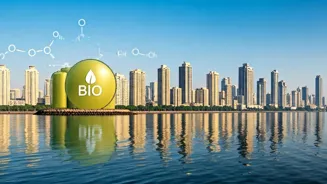Discover how to reduce your business's environmental impact with sustainable supply chains. Learn 7 practical ways!
In today's world, 'going green' isn't just a trend; it's good business sense. Indian businesses
are increasingly aware of the need to reduce their environmental footprint.
A sustainable supply chain simply means managing your entire process, from sourcing raw materials to delivering the final product, in a way that minimizes harm to the environment.
This isn't just about feeling good, it also protects your brand reputation, attracts eco-conscious customers, and can even save you money in the long run. Let's explore seven practical ways your business can create a more sustainable supply chain.
Embrace Transparency and Traceability: Know Where Your Stuff Comes From
The first step towards a greener supply chain is understanding exactly where your products and materials originate. This is all about transparency. Ask yourself: Who are your suppliers? Where are their factories located? What are their environmental practices?
Traceability involves tracking each stage of your product's journey, from the source to the consumer. This allows you to identify potential environmental hotspots and address any issues along the way.
For example, if you are a textile manufacturer, knowing where your cotton is grown and how it's processed will help you ensure ethical and sustainable farming practices. Technology like blockchain can be helpful here, creating a secure and transparent record of your supply chain activities.
This might sound like a lot of work initially, but by mapping your supply chain, you get clear visibility and can make informed decisions. This transparency is critical for gaining consumer trust and maintaining a positive brand image in today's environmentally conscious market.
Optimize Transportation and Logistics: Moving Goods with Less Harm
Transportation is a major contributor to carbon emissions. Optimizing your transportation and logistics can significantly reduce your environmental impact. Start by consolidating shipments to reduce the number of trips.

Explore alternative transportation methods, such as railways or waterways, which are generally more fuel-efficient than road transport. Consider using electric or hybrid vehicles for last-mile deliveries.
Invest in route optimization software to find the most efficient routes, minimizing fuel consumption and delivery times. Collaborating with other businesses to share transportation resources can also lead to significant reductions in emissions.
Moreover, focusing on local sourcing can reduce transportation distances altogether. By making these changes, you'll not only shrink your carbon footprint but also potentially save money on fuel and transportation costs. Remember that packaging material also have large impact on logistic cost.
Choose Sustainable Packaging Materials: Ditch the Plastic
Packaging waste is a huge environmental problem. Switching to sustainable packaging materials is a simple yet effective way to reduce your environmental impact. Replace plastic packaging with biodegradable, compostable, or recycled alternatives.
Consider using materials like cardboard, paper, or plant-based plastics. Design packaging that is minimal and reusable. Work with your suppliers to reduce unnecessary packaging. Encourage customers to return packaging for reuse or recycling.
Educate customers about the proper disposal of your packaging materials. By embracing sustainable packaging, you can reduce waste, conserve resources, and enhance your brand reputation. Explore innovative packaging solutions like mushroom packaging or seaweed-based alternatives.
Small changes in your businesses' packaging strategy will go a long way in preserving natural resources.
Reduce Waste and Promote Circularity: Close the Loop
The concept of a circular economy is gaining traction, and for good reason. Instead of the traditional linear model of "take, make, dispose," a circular economy aims to minimize waste and keep resources in use for as long as possible.
This means focusing on reducing waste at every stage of your supply chain, from production to consumption. Implement waste reduction programs in your factories and offices. Encourage recycling and composting. Design products that are durable, repairable, and recyclable.
Partner with recycling companies to ensure proper disposal of waste materials. Explore opportunities to reuse or repurpose waste products. For example, textile scraps can be used to make new fabrics or insulation materials.
By adopting a circular approach, you can minimize waste, conserve resources, and create new business opportunities. Remember, this approach encourages you to see waste as a resource rather than a burden.
Conserve Energy and Water: Efficiency is Key
Energy and water consumption are significant environmental concerns. Implementing energy and water conservation measures can significantly reduce your environmental impact and lower your operating costs. Conduct an energy audit to identify areas where you can reduce energy consumption.
Install energy-efficient lighting, appliances, and equipment. Use renewable energy sources, such as solar or wind power. Implement water-saving technologies, such as low-flow toilets and faucets. Repair leaks promptly. Train employees on energy and water conservation practices.
Monitor your energy and water consumption regularly to track your progress. Simple changes, such as turning off lights when leaving a room or using water-efficient irrigation systems, can make a big difference.
By conserving energy and water, you'll not only reduce your environmental footprint but also save money on utility bills.
Engage Suppliers in Sustainability: Collaboration is Crucial
A sustainable supply chain requires collaboration with your suppliers. Engaging your suppliers in your sustainability efforts is crucial for achieving meaningful results. Communicate your sustainability goals to your suppliers. Encourage them to adopt sustainable practices.
Provide training and resources to help them improve their environmental performance. Choose suppliers who prioritize sustainability. Conduct regular audits to ensure that your suppliers are meeting your sustainability standards.
Collaborate with your suppliers to develop innovative solutions for reducing environmental impact. Establishing strong relationships with your suppliers and working together towards common sustainability goals can lead to significant improvements across your supply chain.
Remember that supply chain sustainability is an ongoing process and will need continuous efforts.
Measure and Report Your Progress: Track Your Impact
Finally, it's essential to measure and report your progress on your sustainability initiatives.

Tracking your key performance indicators (KPIs), such as carbon emissions, waste generation, and energy consumption, allows you to assess the effectiveness of your efforts and identify areas for improvement. Report your progress to stakeholders, including customers, investors, and employees.
Transparency is essential for building trust and accountability. Consider using sustainability reporting frameworks, such as the Global Reporting Initiative (GRI) standards, to ensure consistency and credibility.
Regularly review your sustainability goals and strategies to ensure that they remain aligned with your business objectives and the latest environmental trends. By measuring and reporting your progress, you can demonstrate your commitment to sustainability and inspire others to follow suit.
AI Generated Content. Glance/InMobi shall have no liability for the content












